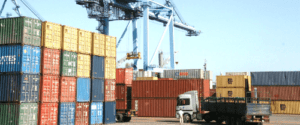Kenya is set to introduce tight screening measures on imports, sparking fears of slow down of cargo clearance at the Mombasa port.
Treasury secretary Henry Rotich said measures to be implemented from as early as July, will see nearly 50 per cent of import cargo scanned. At the moment, only five per cent of the imported consignment is scanned. “We have made plans to acquire state-of-the-art scanners to be stalled at the port of Mombasa,” Mr Rotich said. “We know goods have to move fast, but the issue of security has also become very important to us,” he said. A rigorous scanning is likely to lengthen the time it takes to clear imports at the port. Kenya currently beats most of its East African neighbours by the faster pace at which it clears imports and exports at its ports and borders. The World Bank’s Doing Business 2015 indicates that it takes only 26 days at a cost of Sh226,000 per container to clear imports in Kenya. By comparison, it takes 27 days at a cost of Sh480,000 per container to clear imports in Rwanda and 31 days at a cost of Sh324,000 to clear goods coming into Uganda. “Mombasa port is headed for big changes. A lot of activities will also be taking place around here to ease traffic congestion and improve transport link with other East African markets,” Mr Rotich said last week. He was speaking at a donors’ conference organised in Mombasa to mobilise Sh46.5 billion funding for projects “that will transform the port into a world-class facility.” The conference was organised by TradeMark East Africa (TMEA). The World Bank estimates that an efficiently working port of Mombasa would unlock an additional two percent of the gross domestic product (GDP). Mobilising funds Among other projects, the TMEA is mobilising funds that the Kenya Ports Authority (KPA) requires to relocate Kipevu oil terminal at a cost of Sh14.4 billion ($150 million) to a more spacious area where larger vessels of up to 200,000 tonnes can dock. Development of a lighter wharf at a cost of Sh66.7 billion to store more motor vehicles and project cargo and the deepening of first five berths, at a cost of Sh24.3 billion, to accommodate larger vessels also rank high among the projects.The KPA is also expected to deepen the berths number six to 10 to improve general cargo uptake as well as to undertake second phase of dredging at a cost of Sh14.4 billion to create access to the Dongo Kundu free port and special economic zone.
“A number of youths will get jobs when the projects start. Once the facilities are expanded, the benefit will extend beyond Mombasa to the whole of East Africa”, said Infrastructure principal secretary John Mosonik. The conference was attended by representatives from Japan International Cooperation Agency, World Bank, European Union delegation to Kenya, Development Bank of South Africa, African Development Bank (AfDB) and UK’s DfID. The DfID took the lead, pledging Sh3.5 billion last week to finance the port projects. As at the start of the donors’ conference, the TMEA said it had mobilised just about $50 million out of the $484 million that it requires to expand Mombasa Airport Road and improve the Mombasa Port facilities. Out of the funds, $20 million (Sh2 billion) will be invested in the expanding the 6.4 kilometres Moi International Airport/Port Reitz access road to a dual carriageway. Another $36 million (Sh3.24 billion) has also been mobilised to finance the port infrastructure facility programme which seeks to cut the time that cargo takes to pass through the Mombasa port by two days. “We are focusing on the entire transport system so that our port can fully play its role,” Mr Mosonik. On Friday, Mr Rotich also signed a Sh10.4 billion concessionary loan with the AfDB to finance the expansion of Mombasa-Mariakani Road to dual carriageway. It is estimated that about 4,000 trucks use the road per day, causing a massive traffic jam in Mombasa and delaying shipment to Nairobi and the region’s landlocked states. Source: Business Daily







